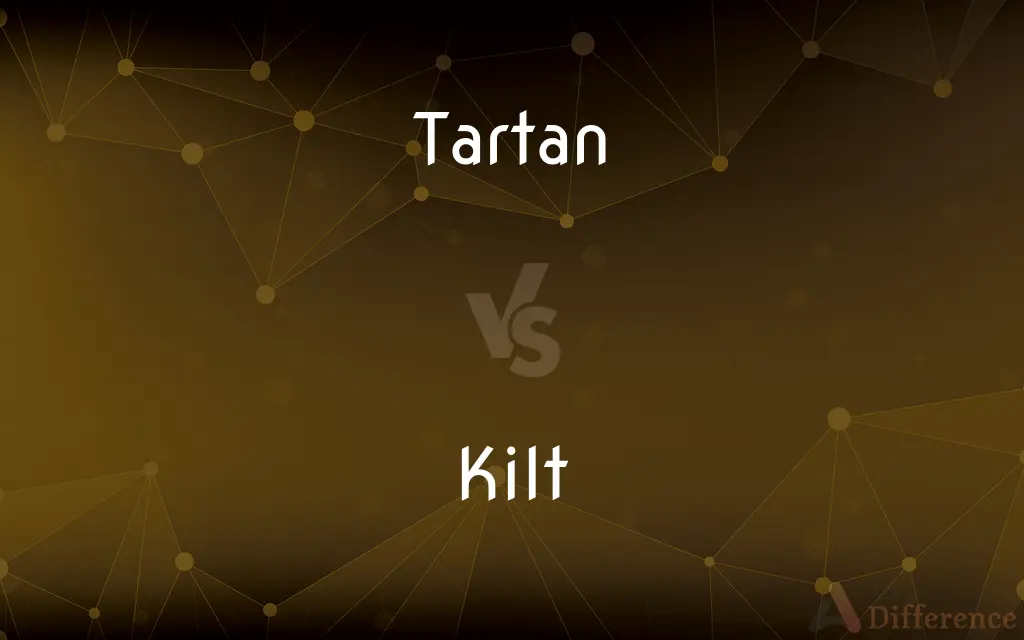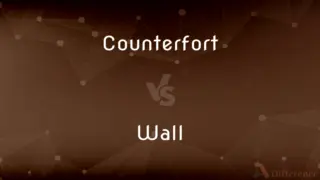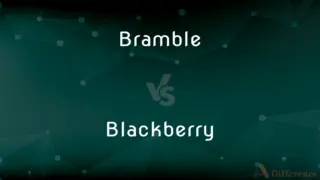Tartan vs. Kilt — What's the Difference?
By Fiza Rafique & Urooj Arif — Updated on March 16, 2024
Tartan is a pattern, while a kilt is a garment.

Difference Between Tartan and Kilt
Table of Contents
ADVERTISEMENT
Key Differences
Tartan is a pattern consisting of criss-crossed horizontal and vertical bands in multiple colors, traditionally associated with Scottish heritage. It's used in various textiles, but most famously in the making of kilts. Kilt, on the other hand, is a knee-length skirt-like garment with pleats at the back, originating from Scotland. It's traditionally made from woolen cloth in a tartan pattern, representing Scottish culture and identity.
While tartan refers specifically to the pattern of the fabric, kilts are garments that often utilize tartan patterns, symbolizing Scottish clans and families.
Tartan patterns are not exclusive to kilts and can be found in other items like scarves, ties, and blankets, whereas kilts are defined by their specific design and cultural significance.
The use of tartan is not limited to kilts or even Scotland, as it has become a popular pattern in various fashion items globally. Kilts, however, retain a strong cultural and ceremonial significance, particularly in Scotland.
Tartans can be registered and are often associated with Scottish clans, each having its unique design. Kilts, while commonly made in these registered tartans, can also be made in solid colors or non-traditional patterns for various purposes.
ADVERTISEMENT
Comparison Chart
Definition
A pattern of criss-crossed horizontal and vertical bands in multiple colors.
A knee-length skirt-like garment with pleats at the back, traditionally worn by men in Scotland.
Origin
Scottish, but used worldwide in various textiles.
Scottish garment traditionally made from tartan wool.
Usage
Used in various textiles like kilts, scarves, and blankets.
A specific garment worn for cultural, ceremonial, or fashion purposes.
Cultural Significance
Associated with Scottish clans and heritage, but also used in broader fashion contexts.
Strongly tied to Scottish identity, with specific kilts representing different clans.
Variability
Tartan patterns can vary widely, with many registered clan designs and generic patterns.
Kilts primarily vary in the tartan pattern used and length, but the basic design remains consistent.
Compare with Definitions
Tartan
Scottish pattern
The MacGregor tartan features a distinctive red and green pattern.
Kilt
Scottish garment
He wore a traditional kilt to the wedding.
Tartan
Clan identity
Each Scottish clan has its own tartan used for kilts and other garments.
Kilt
Cultural significance
Wearing a kilt is a proud display of Scottish heritage.
Tartan
Versatile use
She wrapped herself in a tartan blanket to stay warm.
Kilt
Pleated design
The back of the kilt featured precise, knife-edge pleats.
Tartan
Fashion statement
Tartan trousers are popular in punk fashion.
Kilt
Clan tartans
His kilt was made in the tartan of his ancestral clan.
Tartan
Global appeal
Tartan patterns are used worldwide in various fashion accessories.
Kilt
Modern adaptations
Contemporary kilts come in various fabrics, including leather and denim.
Tartan
Tartan (Scottish Gaelic: breacan [ˈpɾʲɛxkən]) (Irish: breacán) is a patterned cloth consisting of criss-crossed, horizontal and vertical bands in multiple colours. Tartans originated in woven wool, but now they are made in many other materials.
Kilt
A kilt (Scottish Gaelic: fèileadh [ˈfeːləɣ]; Irish: féileadh) is a type of knee-length men’s dress skirt non-bifurcated with pleats at the back, originating in the traditional dress of Gaelic men and boys in the Scottish Highlands. It is first recorded in the 16th century as the great kilt, a full-length garment whose upper half could be worn as a cloak.
Tartan
Any of numerous textile patterns consisting of stripes of varying widths and colors crossed at right angles against a solid background, each forming a distinctive design worn by the members of a Scottish clan.
Kilt
A garment resembling a knee-length skirt of pleated tartan cloth, traditionally worn by men as part of Scottish Highland dress and now also worn by women and girls.
Tartan
A twilled wool fabric or garment having such a pattern.
Kilt
Gather (a garment or material) in vertical pleats.
Tartan
A plaid fabric.
Kilt
Tuck up one's skirts around one's body.
Tartan
A small, single-masted Mediterranean ship with a large lateen sail.
Kilt
A knee-length skirt with deep pleats, usually of a tartan wool, worn as part of the dress for men in the Scottish Highlands.
Tartan
A kind of woven woollen cloth with a distinctive pattern of coloured stripes intersecting at right angles, associated with Scottish Highlanders, different clans and some Scottish families and institutions having their own distinctive patterns.
Kilt
A similar skirt worn by women, girls, and boys.
Tartan
The pattern associated with such material.
Kilt
To tuck up (something) around the body.
Tartan
An individual or a group wearing tartan; a Highlander or Scotsman in general.
Kilt
To gather up (skirts) around the body.
Tartan
Trade name of a synthetic resin, used for surfacing tracks etc.
Kilt
A traditional Scottish garment, usually worn by men, having roughly the same morphology as a wrap-around skirt, with overlapping front aprons and pleated around the sides and back, and usually made of twill-woven worsted wool with a tartan pattern.
Tartan
A type of one-masted vessel used in the Mediterranean.
Kilt
(historical) Any Scottish garment from which the above lies in a direct line of descent, such as the philibeg, or the great kilt or belted plaid
Tartan
(historical) A kind of long covered carriage.
Kilt
A plaid, pleated school uniform skirt sometimes structured as a wraparound, sometimes pleated throughout the entire circumference; also worn by boys in the 19th-century United States.
Tartan
Having a pattern like a tartan.
Kilt
A variety of non-bifurcated garments made for men and loosely resembling a Scottish kilt, but most often made from different fabrics and not always with tartan plaid designs.
Tartan
(humorous) Scottish.
Kilt
A kind of short petticoat, reaching from the waist to the knees, worn in the Highlands of Scotland by men, and in the Lowlands by young boys; a filibeg.
Tartan
(transitive) To clothe in tartan.
Kilt
To tuck up; to truss up, as the clothes.
Tartan
A small coasting vessel, used in the Mediterranean, having one mast carrying large leteen sail, and a bowsprit with staysail or jib.
Kilt
A knee-length pleated tartan skirt worn by men in the Highlands of northern Scotland
Tartan
A cloth having a crisscross design
Common Curiosities
What is tartan?
Tartan is a pattern made of criss-crossed horizontal and vertical bands in multiple colors, often associated with Scottish heritage.
Can tartan be used for garments other than kilts?
Yes, tartan is used in various textiles like scarves, ties, and blankets, not just kilts.
What is the significance of tartan patterns?
Tartan patterns often represent Scottish clans, with each clan having its unique tartan that signifies its identity and heritage.
Can women wear kilts?
Yes, women can and do wear kilts, often as part of modern fashion or in traditional Scottish attire.
Are all kilts made from tartan?
Traditionally, yes, but modern kilts may also be made from solid colors or non-tartan patterns.
Is it disrespectful to wear a tartan not associated with your heritage?
Opinions vary, but wearing a tartan not connected to one's own heritage is generally accepted, especially if done respectfully.
What is a kilt?
A kilt is a knee-length garment with pleats at the back, traditionally worn by men in Scotland and made from tartan-patterned wool.
What occasions are kilts worn for?
Kilts are worn for various occasions, from traditional ceremonies and weddings to cultural festivals and everyday fashion.
Do tartan patterns have specific meanings?
Yes, many tartan patterns are associated with Scottish clans and have historical and familial significance.
How do you choose a tartan?
Many choose tartan based on family heritage, clan affiliation, or simply personal preference.
What's the difference between a tartan and a plaid?
In Scotland, "tartan" refers to the specific pattern, while "plaid" is a type of accessory or garment. Outside Scotland, "plaid" often refers to any tartan-like pattern.
Are there modern variations of kilts?
Modern kilts come in various materials and styles, including utility kilts, which might not use tartan patterns.
How are kilts made?
Kilts are tailored from woolen cloth, with the fabric pleated at the back and wrapped around the wearer's waist.
How do you care for a tartan garment?
Care depends on the material, but woolen tartan garments typically require dry cleaning or gentle hand washing.
Can kilts be worn in formal settings?
Absolutely, kilts are often worn at formal events like weddings and official ceremonies, especially in Scotland.
Share Your Discovery

Previous Comparison
Counterfort vs. Wall
Next Comparison
Bramble vs. BlackberryAuthor Spotlight
Written by
Fiza RafiqueFiza Rafique is a skilled content writer at AskDifference.com, where she meticulously refines and enhances written pieces. Drawing from her vast editorial expertise, Fiza ensures clarity, accuracy, and precision in every article. Passionate about language, she continually seeks to elevate the quality of content for readers worldwide.
Co-written by
Urooj ArifUrooj is a skilled content writer at Ask Difference, known for her exceptional ability to simplify complex topics into engaging and informative content. With a passion for research and a flair for clear, concise writing, she consistently delivers articles that resonate with our diverse audience.














































